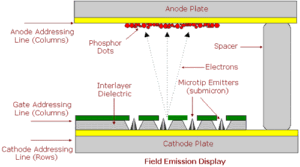When Display Monitor began publication in 1994, one of the technologies being tipped as representing the future of flat panel displays was the FED or Field Emission Display.
Similar in principle to a CRT, the FED uses a beam of electrons to excite phosphors which then emit visible light. Unlike a CRT, it uses multiple electron emitters for each pixel in the display. The basic concept therefore requires no beam steering circuitry and can be made as shallow as the depth of 10mm. Another bonus is that the electrons in a FED are not produced by heat, as they are in a CRT, so the display does not need to warm up and does not produce large amounts of unwanted heat. It has several advantages over LCDs as well: it requires no back light, is very light, has a very wide viewing angle, its response time is very short, it has a very high contrast ratio and has excellent colour properties. The first generation of FEDs uses tiny, conical electron emitters (known as a “Spindt tip”) but in the future there could be versions using carbon nanotubes which have been demonstrated by Samsung. Nanotubes are potentially a more efficient electron emitter than the Spindt tip.
As with LCD technology, the basic idea of the FED has surfaced in several different formats. The two main schools of development have been based on a choice between using high and low voltage phosphors. Low voltage phosphors allow for a thinner display, but there have been significant problems in finding materials with a sufficient brightness and efficiency. High voltage phosphors, similar to those used in CRTs, have a good lifetime, but the gap between the emitter and the phosphor needs to be bigger because of the higher voltages. The larger gap means that some kind of beam focusing system is needed to ensure that the electrons hit the correct phosphor dot.
Back in 1994, SI Diamond announced the Diode Field Emission Display (DFED). This replaces the protruding electron emitter of the FED with a plate coated by a deposit of carbon in diamond. However, by the middle of 1997, the company announced that it was to concentrate on using the technology on lamps for stadium displays and has since demonstrated high brightness devices. Later that year, a UK consortium announced that it would be using a similar system to produce, ironically, backlights for LCDs.
Despite the high expectations of a few years ago, the FED has proved difficult to develop and many companies which invested a lot of time, money and effort into FED development have decided to move to other technology. An interesting development of the general FED principle is Canon’s SEDdisplay.
Update: Some companies continue to try to develop commercially viable FEDs and many of these are based on the use of Carbon Nanotubes (CNTs) as emitters.

